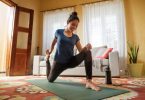It’s possible that people with rheumatoid arthritis (RA) who exercise experience lower pain than those who don’t. Exercise improves mood, increases range of motion, enhances joint function, and minimises uncomfortable symptoms
See a doctor before beginning any exercise programme is recommended, and you should work with a physiotherapist and a doctor to create a personalised exercise schedule.
6 Best Exercises for Rheumatoid Arthritis Pain
The pain, stiffness in the joints, and other symptoms that RA might cause may be reduced with the exercise types mentioned below:-
1. Stretching
Stretching can assist enhance range of motion, decreasing stiffness, and increasing flexibility. Daily stretching is crucial for reducing RA symptoms.
Each person will require a customised stretching regimen, depending on their symptoms and the impacted joints. But stretching frequently entails moving the knee, hand, and elbow joints slowly and softly.
A regular stretching routine could include:
- Spending three to five minutes sitting, standing, or pumping the arms while warming up.
- Each stretch should be held for 20-30 seconds before being released.
- Each stretch should be replicated 2-3 times. Using a yoga strap while stretching may help people maintain proper form. Someone could use an alternative, like a dog leash, if they don’t have a yoga strap.
If your doctor suspects that you have an autoimmune condition like lupus, rheumatoid arthritis, or scleroderma, they will likely prescribe an ANA test.
Some patients may find it helpful to work with a physical therapist familiar with RA to learn the proper technique for carrying out the appropriate stretches for their unique needs.
2. Flowing exercises like yoga and tai chi
Tai chi and yoga include slow, flowing movements, meditation, and deep breathing. They reduce tension while improving flexibility, balance, and range of motion.
Tai chi has been shown in a study of RA patients who participated in group tai chi to decrease anxiety and depression while boosting self-motivation and self-esteem.
For 12 weeks, the participants practised tai chi twice a week.
According to a study of Iyengar yoga practitioners who have RA, this form of exercise may help with pain, exhaustion, and mood issues. For six weeks, the participants practised yoga twice each week.
Taiji or yoga exercises can be found in free internet videos or mobile applications, and there are some yoga exercises designed especially for persons with RA. Always with your doctor before beginning a yoga or tai chi routine.
3. Walking
 f
f
Walking is a low-impact workout that can enhance aerobic fitness, heart and joint health, and mood.
Even if the walking is not hard, it is still essential to wear the right shoes and drink plenty of water. Walking slowly at first and then picking up the pace once possible is often preferable.
Before advancing to uphill, downhill, or rough terrain, an individual may want to start a walking routine on flat, even surfaces.
4. Water Exercises
Water helps sustain body weight by reducing gravity; therefore, water exercises have less of a negative impact on the joints.
Flexibility, range of motion, strength, and aerobic fitness can all be improved with swimming, water aerobics, and other light water workouts. Furthermore, they might reduce the stiffness and tension of the joints.
There is a need for more research on the advantages of water exercises for rheumatoid arthritis.
5. Strength Training

Increased strength can be achieved while minimising pain and other RA symptoms by strengthening the muscles surrounding the injured joints. Strength training has many benefits for people with rheumatoid arthritis.
Using a resistance band is an excellent way of challenging your body while also building muscle over time. A physiotherapist treating RA patients should be able to advise on appropriate exercises.
6. Hand Exercises
RA can occasionally result in hand use that is restricted. A person with RA could experience grip weakness or start dropping objects.
Squeezing a stress ball, slowly curling the fingers, spreading the fingers wide on a table, and bending the wrists up and down can all assist the hands to become more flexible and strong.
Exercise Recommendations for RA Patients
In order to exercise safely and comfortably with RA, consider the following advice:
- Accessorize for comfort and safety
People can exercise more comfortably and safely by using the following techniques:
- selecting footwear that offers the appropriate protection and balance
- using a yoga mat that won’t slide
- putting on comfortable clothing that quickly drains sweat.
- Seek Variety
The symptoms of RA can change every day and typically occur in waves. People frequently go through flare-ups and remissions.
People can prevent overworking one group of muscles or specific joints by performing a range of workouts and switching up their daily routine.
For instance, if one chooses to add weight training twice weekly, a water workout once weekly, and yoga or tai chi twice weekly, depending on their symptoms.
This variety ought to guard against overuse injuries, which can worsen symptoms and nullify the therapeutic benefits of exercise.
- Exercises should be adjusted based on symptoms
On days when symptoms are worse, exercise intensity might be decreased. Instead of holding a resistance band in their hands, they could, for instance, wrap it over their forearms.
They can also try a new kind of exercise or exercise for a shorter period.
Switching this exercise to a stroll or stretching will still be helpful on days when cycling or swimming seems too much.
- Be Consistent
To see accurate results, people must constantly exercise. It’s crucial to continue and practise frequently.
Regular and lifelong aerobic and muscular strengthening exercises will benefit a person with RA.
A few days may be more uncomfortable than the others, but the concentration can be adjusted accordingly.
Exercises to Avoid
High-intensity workouts or any exercise that causes people with RA should avoid pain. High-impact activities that put a tremendous burden on the joints may fall into this category.
There are, however, no forms of exercise that someone with RA should avoid. Each person is unique, and an activity that causes pain for one individual may not cause pain for another.
Their situation and health condition will determine what is relevant for someone. Everyone, however, will benefit from paying close attention to their bodies and, if possible, working with a doctor or physical therapist for advice.
Conclusion
People with RA typically benefit from exercising. It has several advantages: discomfort relief, better joint function, increased strength, greater flexibility, assistance with everyday activities, improved cardio fitness, and mood enhancement. It can lessen RA flare-ups and simplify managing this condition’s symptoms.
For the best outcomes, a person should, if at all possible, consult with a doctor and physical therapist to create a customised exercise programme.








